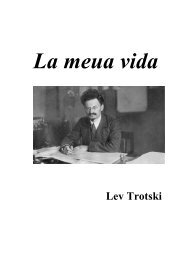determined by the respective quantities or amounts <strong>of</strong> labour, worked up, realized, fixed inthem. The correlative quantities <strong>of</strong> commodities which can be produced in the same time <strong>of</strong>labour are equal. Or the value <strong>of</strong> one commodity is to the value <strong>of</strong> another commodity as thequantity <strong>of</strong> labour fixed in the one is to the quantity <strong>of</strong> labour fixed in the other.I suspect that many <strong>of</strong> you will ask, Does then, indeed, there exist such a vast or any differencewhatever, between determining the values <strong>of</strong> commodities by wages, and determining them bythe relative quantities <strong>of</strong> labour necessary for their production? You must, however, be awarethat the reward for labour, and quantity <strong>of</strong> labour, are quite disparate things. Suppose, forexample, equal quantities <strong>of</strong> labour to be fixed in one quarter <strong>of</strong> wheat and one ounce <strong>of</strong> gold. Iresort to the example because it was used by Benjamin Franklin in his first Essay published in1721, and entitled a modest enquiry into the nature and necessity <strong>of</strong> a paper currency, where he,one <strong>of</strong> the first, hit upon the true nature <strong>of</strong> value.Well. We suppose, then, that one quarter <strong>of</strong> wheat and one ounce <strong>of</strong> gold are equal values orequivalents, because they are crystalizations <strong>of</strong> equal amounts <strong>of</strong> average labour, <strong>of</strong> so manydays' or so many weeks' labour respectively fixed in them. In thus determining the relativevalues <strong>of</strong> gold and corn, do we refer in any way whatever to the wages <strong>of</strong> the agriculturallabourer and the miner? Not a bit. We leave it quite indeterminate how their day's or theirweek's labour was paid, or even whether wages labour was employed at all. If it was, wagesmay have been very unequal. The labourer whose labour is realized in the quarter <strong>of</strong> wheat mayreceive two bushels only, and the labourer employed in mining may receive one-half <strong>of</strong> theounce <strong>of</strong> gold. Or, supposing their wages to be equal, they may deviate in all possibleproportions from the values <strong>of</strong> the commodities produced by them. They may amount to onefourth,one-fifth, or any other proportional part <strong>of</strong> the one quarter <strong>of</strong> corn or the one ounce <strong>of</strong>gold. Their wages can, <strong>of</strong> course, not exceed, not be more than the values <strong>of</strong> the commoditiesthey produced, but they can be less in every possible degree. Their wages will be limited by thevalues <strong>of</strong> the products, but the values <strong>of</strong> their products will not be limited by the wages. Andabove all, the values, the relative values <strong>of</strong> corn and gold, for example, will have been settledwithout any regard whatever to the value <strong>of</strong> the labour employed, that is to say, to wages. Todetermine the values <strong>of</strong> commodities by the relative quantities <strong>of</strong> labour fixed in them, is,therefore, a thing quite different from the tautological method <strong>of</strong> determining the values <strong>of</strong>commodities by the value <strong>of</strong> labour, or by wages. This point, however, will be further elucidatedin the progress <strong>of</strong> our inquiry.In calculating the exchangeable value <strong>of</strong> a commodity we must add to the quantity <strong>of</strong> labourpreviously worked up in the raw material <strong>of</strong> the commodity, and the labour bestowed on theimplements, tools, machinery, and buildings, with which such labour is assisted. For example,the value <strong>of</strong> a certain amount <strong>of</strong> cotton yarn is the crystallization <strong>of</strong> the quantity <strong>of</strong> labour addedto the cotton during the spinning process, the quantity <strong>of</strong> labour previously realized in the cottonitself, the quantity <strong>of</strong> labour realized in the coal, oil, and other auxiliary substances used, thequantity <strong>of</strong> labour fixed in the steam-engine, the spindles, the factory building, and so forth.Instruments <strong>of</strong> production properly so-called, such as tools, machinery, buildings, serve againand again for longer or shorter period during repeated processes <strong>of</strong> production. If they were usedup at once, like the raw material, their whole value would at once be transferred to thecommodities they assist in producing. But as a spindle, for example, is but gradually used up, anaverage calculation is made, based upon the average time it lasts, and its average waste or wearand tear during a certain period, say a day. In this way we calculate how much <strong>of</strong> the value <strong>of</strong>the spindle is transferred to the yarn daily spin, and how much, therefore, <strong>of</strong> the total amount <strong>of</strong>labour realized in a pound <strong>of</strong> yarn, for example, is due to the quantity <strong>of</strong> labour previouslyrealized in the spindle. For our present purpose it is not necessary to dwell any longer upon thispoint.It might seem that if the value <strong>of</strong> a commodity is determined by the quantity <strong>of</strong> labour bestowedupon its production, the lazier a man, or the clumsier a man, the more valuable his commodity,because the greater the time <strong>of</strong> labour required for finishing the commodity. This, however,would be a sad mistake. You will recollect that I used the word "social labour," and many pointsare involved in this qualification <strong>of</strong> "social." In saying that the value <strong>of</strong> a commodity isdetermined by the quantity <strong>of</strong> labour worked up or crystalized in it, we mean the quantity <strong>of</strong>labour necessary for its production in a given state <strong>of</strong> society, under certain social average
conditions <strong>of</strong> production, with a given social average intensity, and average skill <strong>of</strong> the labouremployed. When, in England, the power-loom came to compete with the hand-loom, only halfthe former time <strong>of</strong> labour was wanted to convert a given amount <strong>of</strong> yarn into a yard <strong>of</strong> cotton orcloth. The poor hand-loom weaver now worked seventeen or eighteen hours daily, instead <strong>of</strong> thenine or the hours he had worked before. Still the product <strong>of</strong> twenty hours <strong>of</strong> his labourrepresented now only ten social hours <strong>of</strong> labour, or ten hours <strong>of</strong> labour socially necessary for theconversion <strong>of</strong> a certain amount <strong>of</strong> yarn into textile stuffs. His product <strong>of</strong> twenty hours had,therefore, no more value than his former product <strong>of</strong> ten hours.If then the quantity <strong>of</strong> socially necessary labour realized in commodities regulates theirexchangeable values, every increase in the quantity <strong>of</strong> labour wanted for the production <strong>of</strong> acommodity must augment its value, as every diminution must lower it.If the respective quantities <strong>of</strong> labour necessary for the production <strong>of</strong> the respective commoditiesremained constant, their relative values also would be constant. But such is not the case. Thequantity <strong>of</strong> labour necessary for the production <strong>of</strong> a commodity changes continuously with thechanges in the productive powers <strong>of</strong> labour, the more produce is finished in a given time <strong>of</strong>labour; and the smaller the productive powers <strong>of</strong> labour, the less produce is finished in the sametime. If, for example, in the progress <strong>of</strong> population it should become necessary to cultivate lessfertile soils, the same amount <strong>of</strong> produce would be only attainable by a greater amount <strong>of</strong> labourspent, and the value <strong>of</strong> agricultural produce would consequently rise. On the other hand, if, withthe modern means <strong>of</strong> production, a single spinner converts into yarn, during one working day,many thousand times the amount <strong>of</strong> cotton which he could have spun during the same time withthe spinning wheel, it is evident that every single pound <strong>of</strong> cotton will absorb many thousandtimes less <strong>of</strong> spinning labour than it did before, and consequently, the value added by spinningto every single pound <strong>of</strong> cotton will be a thousand times less than before. The value <strong>of</strong> yarn willsink accordingly.Apart from the different natural energies and acquired working abilities <strong>of</strong> different peoples, theproductive powers <strong>of</strong> labour must principally depend: -Firstly. Upon the natural conditions <strong>of</strong> labour, such as fertility <strong>of</strong> soil, mines, and so forth.Secondly. Upon the progressive improvement <strong>of</strong> the social powers <strong>of</strong> labour, such as arederived from production on a grand scale, concentration <strong>of</strong> capital and combination <strong>of</strong> labour,subdivision <strong>of</strong> labour, machinery, improved methods, appliance <strong>of</strong> chemical and other naturalagencies, shortening <strong>of</strong> time and space by means <strong>of</strong> communication and transport, and everyother contrivance by which science presses natural agencies into the service <strong>of</strong> labour, and bywhich the social or co-operative character <strong>of</strong> labour is developed. The greater the productivepowers <strong>of</strong> labour, the less labour is bestowed upon a given amount <strong>of</strong> produce; hence thesmaller the value <strong>of</strong> the produce. The smaller the productive powers <strong>of</strong> labour, the more labouris bestowed upon the same amount <strong>of</strong> produce; hence the greater its value. As a general law wemay, therefore, set it down that:The values <strong>of</strong> commodities are directly as the times <strong>of</strong> labour employed in theirproduction, and are inversely as the productive powers <strong>of</strong> the labour employed.Having till now only spoken <strong>of</strong> value, I shall add a few words about price, which is a peculiarfrom assumed by value.Price, taken by itself, is nothing but the monetary expression <strong>of</strong> value. The values <strong>of</strong> allcommodities <strong>of</strong> the country, for example, are expressed in gold prices, while on the Continentthey are mainly expressed in silver prices. The value <strong>of</strong> gold or silver, like that <strong>of</strong> all othercommodities is regulated by the quantity <strong>of</strong> labour necessary for getting them. You exchange acertain amount <strong>of</strong> your national products, in which a certain amount <strong>of</strong> your national labour iscrystallized, for the produce <strong>of</strong> the gold and silver producing countries, in which a certainquantity <strong>of</strong> their labour is crystallized. It is in this way, in fact by barter, that you learn toexpress in gold and silver the values <strong>of</strong> all commodities, that is the respective quantities <strong>of</strong>labour bestowed upon them. Looking somewhat closer into the monetary expression <strong>of</strong> value, orwhat comes to the same, the conversion <strong>of</strong> value into price, you will find that it is a process bywhich you give to the values <strong>of</strong> all commodities an independent and homogeneous form, or bywhich you express them as quantities <strong>of</strong> equal social labour. So far as it is but the monetaryexpression <strong>of</strong> value, price has been called natural price by Adam Smith, "prix necessaire" by
- Page 4:
égime, which has been through its
- Page 7:
sins of all state forms. That this
- Page 13 and 14:
It has not occurred to any one of t
- Page 15 and 16:
gradually accumulated small capital
- Page 17 and 18:
from this nonsensical ‘prehistory
- Page 19 and 20:
property: the nucleus, the first fo
- Page 21 and 22:
which produces in all nations simul
- Page 23 and 24:
[8. The Inconsistency of the Ideali
- Page 25 and 26:
The ‘essence’ of the fish is it
- Page 27 and 28:
hence of the relationships which ma
- Page 29 and 30:
labour. In the first case, therefor
- Page 31 and 32:
production and commerce soon calls
- Page 33 and 34:
period begins with the Navigation L
- Page 35 and 36:
more advanced countries, still have
- Page 37 and 38:
over against the individuals, so th
- Page 39 and 40:
eality is only a product of the pre
- Page 41 and 42:
never became more than a city; its
- Page 43 and 44:
Only at this stage does self-activi
- Page 45 and 46:
Modern industry has established the
- Page 47 and 48: these crises, there breaks out an e
- Page 49 and 50: Further, as we have already seen, e
- Page 51 and 52: abolish that; the development of in
- Page 53 and 54: For the rest, nothing is more ridic
- Page 55 and 56: III. Socialist and Communist Litera
- Page 57 and 58: conscious of having overcome “Fre
- Page 59 and 60: The undeveloped state of the class
- Page 61 and 62: The Paris CommuneAddress to the Int
- Page 63 and 64: priests were sent back to the reces
- Page 65 and 66: pregnant. In the full consciousness
- Page 67 and 68: subjected Versailles and the rest o
- Page 69 and 70: The Eighteenth Brumaire of Louis Bo
- Page 71 and 72: For the rest, every fair observer,
- Page 73 and 74: that here “bourgeois republic”
- Page 75 and 76: Eternalization of historic relation
- Page 77 and 78: and becomes a direct object and ser
- Page 79 and 80: each supplies the other with its ob
- Page 81 and 82: generally. The question evidently b
- Page 83 and 84: is thus the only reality, the movem
- Page 85 and 86: smudge over all historical differen
- Page 87 and 88: elations. Thus e.g. the relation of
- Page 89 and 90: a rise of wages, because every reac
- Page 91 and 92: equally spent upon all articles of
- Page 93 and 94: Apart from some years of failing ha
- Page 95 and 96: enable a currency to adapt itself t
- Page 97: Smith and his French predecessors h
- Page 101 and 102: in a commodity constitutes its valu
- Page 103 and 104: y working which the working man wou
- Page 105 and 106: just seen that the surplus value co
- Page 107 and 108: increased value of his labour, like
- Page 109 and 110: altogether, is sure to have his wag
- Page 111 and 112: theory, which consists in putting a
- Page 113 and 114: Preface to A Contribution to the Cr
- Page 115 and 116: Capital, Volume I (1867)From the Pr
- Page 117 and 118: A use value, or useful article, the
- Page 119 and 120: imposed necessity, without which th
- Page 121 and 122: embodiments of one identical social
- Page 123 and 124: abstract. The twofold social charac
- Page 125 and 126: ased on the production of commoditi
- Page 127 and 128: Capital Vol. III. Chapter 2. The Ra
- Page 129 and 130: specific relationship to surplus-va


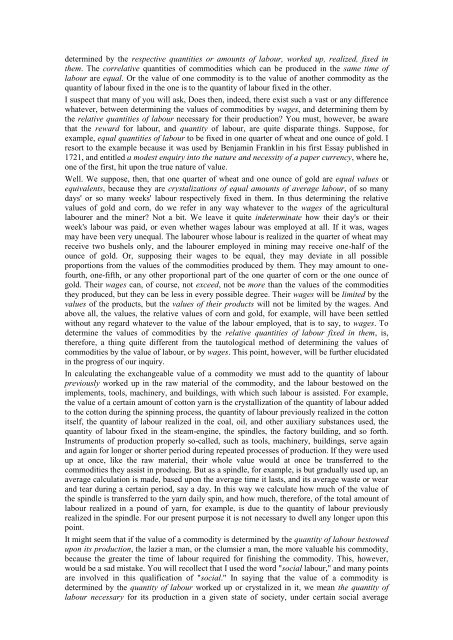
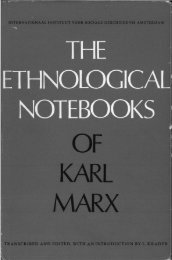

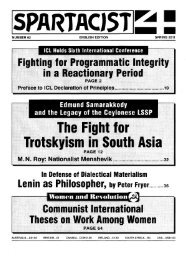

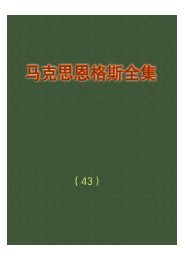
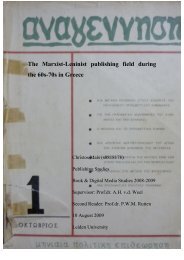

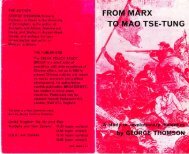

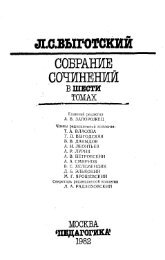
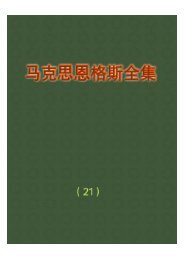
![tyf Enf=O=n]lgg](https://img.yumpu.com/47584932/1/190x245/tyf-enfonlgg.jpg?quality=85)
